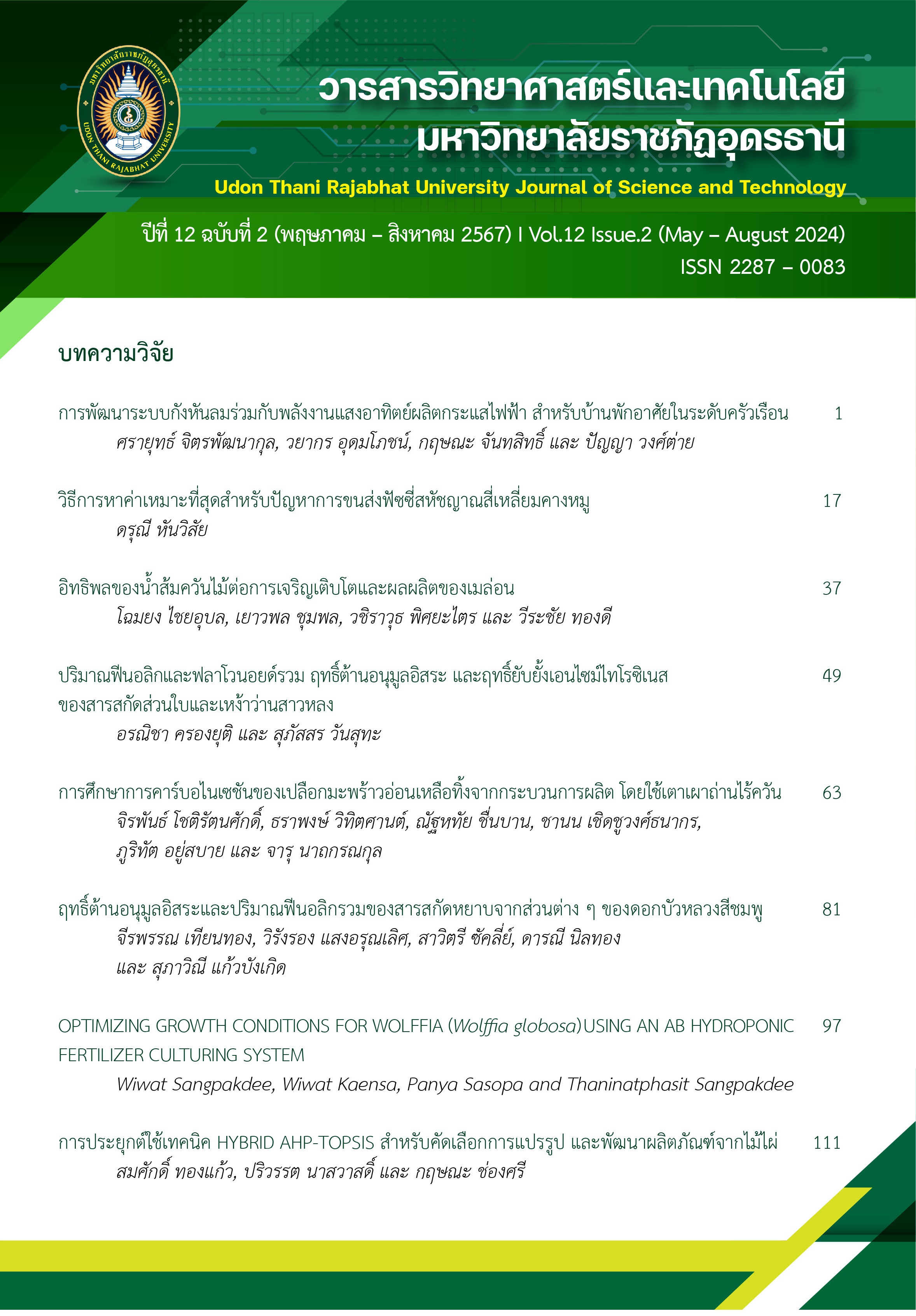TOTAL PHENOLIC AND FLAVONOID CONTENT, ANTIOXIDANT, TYROSINASE INHIBITION ACTIVITIES OF AMOMUM BIFLORUM JACK EXTRACT.
Main Article Content
Abstract
This research aimed to determine the antioxidant activity, tyrosinase inhibition activity, total phenolic content and total flavonoid content of Amomum biflorum Jack. It is divided into 2 parts: the leaves and rhizomes of Amomum biflorum Jack. The extracts were prepared by using solvents 95% ethanol. The antioxidant activity was determined by 2, 2–diphenyl–1–picrylhydrazyl (DPPH assay). The tyrosinase inhibition activity was determined by using the Dopachrome method. Total phenolic content was analyzed by the Folin-Ciocalteuassay and total flavonoid content was analyzed by the Aluminum chloride colorimetric assay. From the results, it was found that the crude 95% ethanol extract of Amomum biflorum Jack leaf exhibited the most potent antioxidant activity determined by DPPH assay (IC50= 2,085.64 ± 2.86 µg/mL). Moreover, it exhibited the strongest tyrosinase inhibition activity (IC50= 262.02 ± 5.89 µg/mL) and the highest total phenolic and flavonoid content (total phenolic = 21.92 ± 0.79 mg GAE/g extract, total flavonoid = 14.12 ± 0.12 mg QE/g extract) This research demonstrates that Amomum biflorum Jack leaf is considered to be an interesting source of bioactive compounds. It may be an alternative herb for cosmetic applications, Herbal products and further research in pharmacology for the development of active drug compounds.
Article Details
References
รัตนา อินทรานุปกรณ์. (2547). การตรวจสอบและการสกัดแยกสารสำคัญจากสมุนไพร. กรุงเทพฯ: สำนักพิมพ์แห่งจุฬาลงกรณ์มหาวิทยาลัย.
ลัดดาวัลย์ พะวร, คงศักดิ์ บุญยะประณัย, อรอุมา จันทร์เส, มินตรา อานนท์, สุพจน์ ทับทิมให และ อนุสรา อันพิมพ์. (2022). ฤทธิ์ต้านอนุมูลอิสระฤทธิ์ยับยั้งเอนไซม์ไทโรซิเนส และอีลาสเตสของผัก 10 ชนิด ในจังหวัด นครราชสีมา. Journal of Science & Technology MSU, 41(6), 277-284.
ศิริพรรณ สุขขัง, สมนึก พรมแดง และ สายน้ำอ้อย สว่างเมฆ. (2560). ผักพื้นบ้านรสเปรี้ยวในการเปนแหล่งของสารออกฤทธิ์ทางชีวภาพ. ใน เรื่องเต็มการประชุมทางวิชาการ ครั้งที่ 55 มหาวิทยาลัยเกษตรศาสตร์ (หน้า 288-295). กรุงเทพฯ: มหาวิทยาลัย เกษตรศาสตร์.
สนั่น ศุภธีรสกุล และ กชกร มุสิกพงษ์. (2557). ผลต่อการผ่อนคลายในอาสาสมัครของน้ำมันหอมระเหยจากว่านสาวหลง. วารสารมหาวิทยาลัยทักษิณ, 7, 17-25.
Chan, E. W. C., Lim, Y. Y., Wong, L. F., Lianto, F. S., Wong, S. K., Lim, K. K., & Lim, T. Y. (2008). Antioxidant and tyrosinase inhibition properties of leaves and rhizomes of ginger species. Food chemistry, 109(3), 477-483.
Chang, Q., Zuo, Z., Harrison, F., & Chow, M. S. S. (2002). Hawthorn. The Journal of Clinical Pharmacology, 42(6), 605-612.
Chu, Y. H., Chang, C. L., & Hsu, H. F. (2000). Flavonoid content of several vegetables and their antioxidant activity. Journal of the Science of Food and Agriculture, 80(5), 561-566.
Ebanks, J. P., Wickett, R. R., & Boissy, R. E. (2009). Mechanisms regulating skin pigmentation: the rise and fall of complexion coloration. International journal of molecular sciences, 10(9), 4066-4087.
Halliwell, B., & Gutteridge, J. (2007). Free Radicals in Biology and Medicine. 4th ed. New York: Oxford University Press.
Hongsiri, A., & Duanyai, S. (2022). Antioxidant Activity, Total phenolic and Essential Oil from Amomum biflorum Jack: ฤทธิ์ต้านอนุมูลอิสระสารประกอบฟีนอลิกและองค์ประกอบทางเคมีของน้ำมันหอมระเหยว่านสาวหลง. Advanced Science Journal, 22(2), R36-R47.
Kim, Y. J., & Uyama, H. (2005). Tyrosinase inhibitors from natural and synthetic sources: structure, inhibition mechanism and perspective for the future. Cellular and molecular life sciences. 62, 1707-1723.
Polsena, P. (2007). Khoa Hin Son Botanic Gardens (Complete version). Bangkok, Thailand: Jetanaromphan Printing. (in Thai)
Singleton, V. L., & Rossi, J. A. (1965). Colorimetry of total phenolics with phosphomolybdic-phosphotungstic acid reagents. American journal of Enology and Viticulture, 16(3), 144-158.
Singtothong, C., Gagnon, M. J., & Legault, J. (2013). Chemical composition and biological activity of the essential oil of Amomum biflorum. Natural Product Communications, 8(2), 265-267.
Srisook, K., Salee, P., Charoensuk, Y., & Srisook, E. (2010). In vitro anti-oxidant and anti-tyrosinase activities of the rhizomal extracts from Amomum biflorum Jack. Thai Journal of Botany, 2, 143–150.
Uthairung, A., Rattarom, R., & Mekjaruskul, C. (2020). Cosmeceutical applications of essential oils of Amomum biflorum Jack from whole plant and rhizome. Thai Journal of Science and Technology, 9(5), 680-692.


